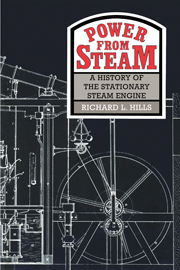Book contents
- Frontmatter
- Contents
- Preface
- Acknowledgements
- List of figures
- List of tables
- 1 The noblest machine
- 2 The impellent force of fire
- 3 Common old smoaking engines
- 4 The economy of power
- 5 The devil of rotations
- 6 Such unbounded power
- 7 Good servants but bad masters
- 8 An uncultivated field
- 9 The new theory of heat
- 10 The internal operation of the machine
- 11 Such absolute smoothness
- 12 Twinkle twinkle little arc
- 13 The drive for efficiency
- 14 An economical source of motive power
- 15 The most economical mode of obtaining power
- Notes
- Bibliography
- Index
15 - The most economical mode of obtaining power
The first steam turbines (1880–1920)
Published online by Cambridge University Press: 01 June 2011
- Frontmatter
- Contents
- Preface
- Acknowledgements
- List of figures
- List of tables
- 1 The noblest machine
- 2 The impellent force of fire
- 3 Common old smoaking engines
- 4 The economy of power
- 5 The devil of rotations
- 6 Such unbounded power
- 7 Good servants but bad masters
- 8 An uncultivated field
- 9 The new theory of heat
- 10 The internal operation of the machine
- 11 Such absolute smoothness
- 12 Twinkle twinkle little arc
- 13 The drive for efficiency
- 14 An economical source of motive power
- 15 The most economical mode of obtaining power
- Notes
- Bibliography
- Index
Summary
Immediately after the First World War, the cotton textile industry entered a period of boom as manufacturers tried to catch up on orders that had been delayed by that war. However this was short-lived because some countries to which Britain had been accustomed to export cloth had developed their own capacity for spinning and weaving. In Lancashire, some mills in the course of construction when the war started, like the Ace Mill at Chadderton, were completed when it finished. But then others which it was intended should be doubled like the Hare Mill (renamed Mons after the war) at Todmorden, and the Pear Mill, Stockport, never had the second section added. The last three traditional style Lancashire cotton spinning mills were finished in 1926 and 1927 and each was driven in a different way.
For the Wye Mill Co.'s No. 2 Mill, Shaw, Buckley & Taylor built their largest and last engine in the traditional style with 50 ropes round a 24 ft diam. flywheel weighing 90 tons driving the shafting. It was a cross compound designed to develop 2,500 h.p. with cylinders 32 and 70 in bore by 5 ft stroke. The speed was a stately 66 r.p.m. The parts were massive to take such power at such a slow speed with the enormous single slipper crossheads. Even these huge castings proved to be inadequate when the foundations at the back of the lowpressure cylinder settled and the crosshead guides cracked.
- Type
- Chapter
- Information
- Power from SteamA History of the Stationary Steam Engine, pp. 281 - 292Publisher: Cambridge University PressPrint publication year: 1989



